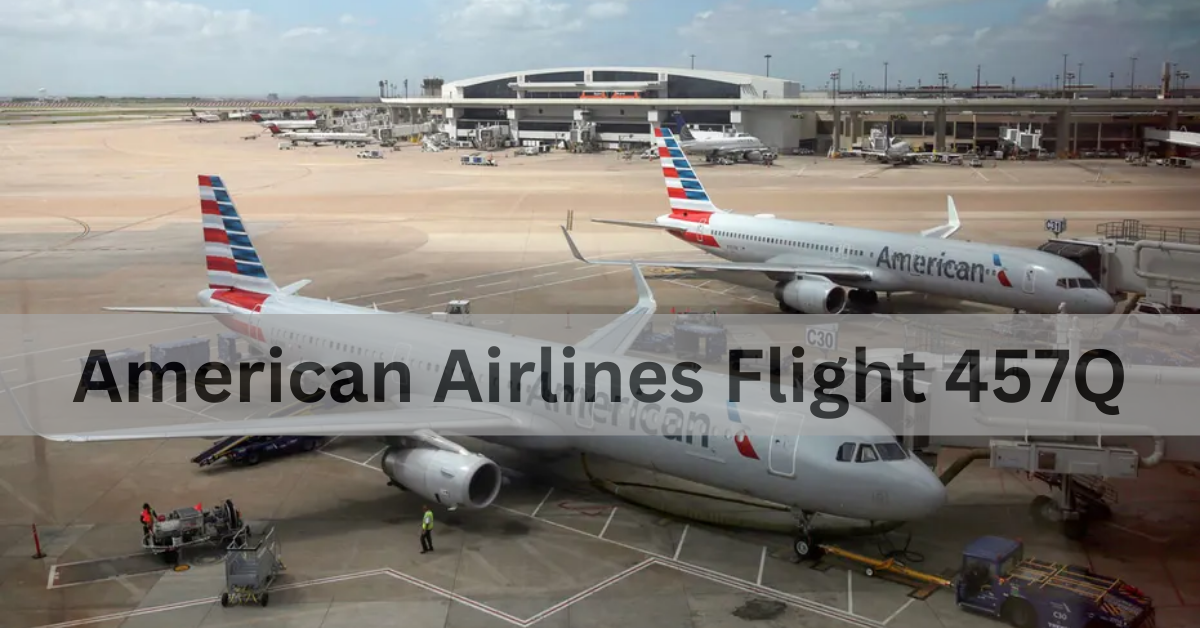Have you ever had a flight that started off as routine but ended up being a rollercoaster of emotions? Well, let me tell you about American Airlines Flight 457Q, a journey that I won’t forget anytime soon.
American Airlines Flight 457Q was flying from New York’s JFK Airport to Los Angeles when it hit strong turbulence and a mechanical problem. This forced the plane to make an emergency landing at LAX on June 13, 2024.
In this article, I’ll take you through the details of what happened on Flight 457Q, the lessons learned, and how everyone onboard came together in a moment of crisis.
Table of Contents
Smooth Departure And Routine Flight Overview Of American Airlines Flight 457Q:
The Routine Start
American Airlines Flight 457Q departed from John F. Kennedy International Airport (JFK) in New York on June 13, 2024, scheduled for an 8:32 AM departure time. The flight, operated using a Boeing 737-800 aircraft, was routine in its early stages, with 160 passengers and 6 crew members on board. Passengers boarded the aircraft expecting a standard cross-country flight to Los Angeles International Airport (LAX).
Climb to Cruising Altitude
Following an uneventful takeoff, the flight ascended smoothly to its designated cruising altitude of 37,000 feet. Weather conditions were initially favorable, and both passengers and crew settled in for what they anticipated would be a routine journey across North America. The first hours of the flight were marked by normalcy as the aircraft made its way westward towards its destination.
This segment of the journey set the stage for what would later become a dramatic turn of events, as mechanical issues and severe turbulence disrupted the tranquility of Flight 457Q.
Mid-Flight Crises – Safeguarding Aircraft Safety And Passenger Comfort!
During a flight, a ‘mid-flight crisis’ refers to sudden and unexpected events that can threaten the safety of the aircraft. These crises vary, like when something goes wrong with the plane (like an engine problem), severe turbulence shakes the plane, someone gets seriously ill, or there’s a security issue.
Characteristics of Mid-Flight Crises:
- Mechanical Failures: These are common and can cause sudden noises, vibrations, or loss of functions that require quick action from the crew to land safely.
- Severe Turbulence: This can happen due to weather or other planes and can cause the plane to shake violently, potentially hurting passengers.
- Medical Emergencies: If someone gets very sick, the crew needs to act fast, possibly talking to doctors on the ground and landing at the nearest airport.
- Security Threats: Rare but serious, like unruly passengers or threats, require specific protocols to keep everyone safe.
Response to Mid-Flight Crises:
- Crew Training: Crews are trained a lot to handle these crises, with practice drills to help them stay calm and know what to do.
- Communication: Good communication between crew, air traffic control, and ground staff is crucial to making quick decisions and keeping everyone safe.
- Passenger Safety: Keeping passengers safe and calm is always the priority, with flight attendants helping with emergency procedures and medical help when needed.
Navigational Crisis Management – How Flight Crews Handle Emergencies!
The crew of American Airlines Flight 457Q faced a crisis when the plane encountered severe turbulence and mechanical issues. This turbulence made the plane unstable and increased concerns among both crew and passengers.
During the crisis, effective communication among the crew was crucial. The pilots kept in constant touch with air traffic control to get updates and guidance. This clear communication helped them make informed decisions, like diverting the flight to Los Angeles for an emergency landing.
Deciding to land the plane in an emergency is a serious choice. It involves checking how bad the plane’s problems are, the weather, and where it can land safely. The crew of Flight 457Q carefully considered all these factors to ensure everyone on board stayed safe.
Throughout the incident, flight attendants played a key role in keeping passengers calm. They gave regular updates, reassurance, and support to ease fears and help passengers understand what was happening. Their calmness and support were crucial in managing the crisis and making sure the emergency landing went well.
Emergency Landing at LAX – Discover How Flight 457Q’s Emergency Landing At LAX Unfolded!
Flight 457Q was flying towards Los Angeles International Airport (LAX) when it faced strong shaking and problems with its left engine. The pilots decided to make an emergency landing due to these issues.
When they landed at LAX, emergency teams quickly came to check the plane. They found damage on the outside of the plane, especially around the middle and the left engine.
Passengers were scared because of the shaking and loud noises during the flight. They were comforted by the calm crew who explained what was happening.
After landing safely, passengers were very relieved. A few had minor injuries from the sudden movements, but luckily, nobody was seriously hurt.
Flight 457Q couldn’t fly again right away. It needed to be thoroughly checked and fixed before it could be used for more flights. This ensured that it was safe for everyone on board.
Lessons Learned And Safety Enhancements – How These Enhancements Ensure Safer Flights For Passengers!
After American Airlines Flight 457Q had a mechanical problem, the aviation industry learned important lessons and made safety improvements:
- Better Maintenance: American Airlines now checks planes more often and more carefully to catch problems before they become serious.
- Training Upgrades: Crew members are getting more training to handle emergencies like severe turbulence or mechanical failures.
- Improved Communication: They’ve improved how pilots and air traffic controllers talk to each other during emergencies, practicing these skills regularly.
- Emergency Plans: Airlines reviewed their plans for emergencies to make sure they work well, including how they inform passengers and coordinate with emergency services.
- Safer Passenger Information: They updated safety briefings for passengers to explain what to do during turbulent flights or if something goes wrong, making travel safer for everyone.
Inside the Turbulence – A Detailed Look at Passenger Experiences!
Passengers on American Airlines Flight 457Q went through a rollercoaster of emotions during a turbulent flight and emergency landing.
When the flight hit severe turbulence, passengers felt scared and uncertain. The plane shook violently, making some people panic. They described gripping their seats tightly as the aircraft suddenly dropped in altitude, accompanied by loud banging noises from mechanical issues.
The flight attendants played a crucial role in calming everyone down. They communicated clearly and kept passengers informed. As the plane approached Los Angeles for an emergency landing, people were both relieved and tense. They held their breath as the pilots brought the damaged plane safely to the runway.
After landing safely at LAX, passengers were incredibly relieved and thankful to the crew for handling the emergency so well. Many applauded and thanked the crew members. Some passengers gained a new appreciation for aviation safety measures.
People’s personal stories varied widely. Some said it was the scariest moment of their lives, while others emphasized how everyone supported each other. These stories showed how people cope with tough situations and highlighted the human side of air travel safety.
Insights into Aircraft Repair Processes After Emergency Landings – Explore the meticulous steps taken to restore aircraft safety!
After an emergency landing due to mechanical problems, airplanes go through a thorough inspection and fixing process to make sure they’re safe to fly again. Mechanics first check how much damage there is, especially in places like the middle part and the left engine that got hit. Then they make a plan to fix everything that’s broken, focusing on making the plane safe and working well again.
If there’s damage to the structure, experts use specific methods and materials to repair it so the plane stays strong. For problems with the left engine, they carefully check and repair it by replacing any broken parts and testing it thoroughly to ensure it runs safely. After all the repairs are done, the plane goes through detailed safety tests to check that all systems, especially those affected by the emergency, are working perfectly and meet strict safety rules.
Once the plane passes these tests, aviation authorities give it the green light to fly again. This means they’ve confirmed that the plane is safe and ready to go back to regular flights. Though specific details about Flight 457Q’s repairs weren’t shared, this process shows how planes are typically fixed after emergency landings, focusing on safety every step of the way.
Frequently Asked Questions (FAQs)
1. What caused the mechanical issues on Flight 457Q?
The exact cause was determined to be a malfunction in the aircraft’s left engine, which led to the severe rattling and loud bangs heard by passengers. The engine issue, coupled with the encountered turbulence, significantly challenged the flight crew’s ability to stabilize the plane.
2. How did the crew manage the situation?
The crew managed the situation with exceptional professionalism. The pilots focused on maintaining control of the aircraft and coordinating with air traffic control, while the flight attendants kept passengers calm and provided necessary support throughout the ordeal.
3. Were there any injuries reported?
There were no serious injuries reported among passengers or crew members. However, some passengers experienced minor injuries due to the severe turbulence and the physical jostling during the flight’s final moments before landing (techopedia.co.uk).
4. How was the aircraft’s condition after landing?
The aircraft sustained visible damage, particularly around its midsection and the left engine. This damage rendered it unfit for further flights until comprehensive repairs and safety checks could be conducted (Blog Reign).
Conclusion
American Airlines Flight 457Q showed how well pilots, crew, and passengers handled tough problems like mechanical issues and rough flying. They worked together to keep everyone safe. This event reminds us of the difficulties in flying and how people can work together in tough situations.
It’s a lesson that will help make flying even safer in the future as the aviation industry keeps improving.



